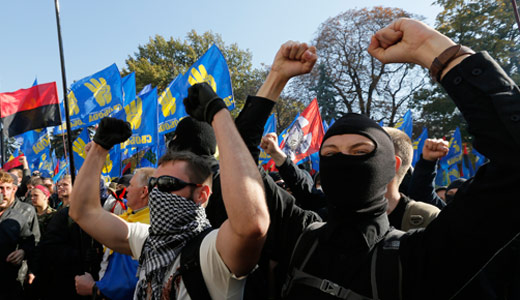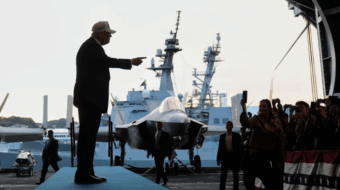
On Monday October 14, thousands of ultra-rightist Ukrainian protesters besieged the national parliament in Kiev, attacking police guards and injuring 15 of them. About 50 protesters are reported to have been arrested.
The demands of the protesters, who were led by the fascist Svoboda Party and the equally extremist Right Sector, Pravy Sektor, were for recognition of the Ukrainian Insurgent Army (UPA), which fought during World War II, mostly on the German side, to be recognized as a patriotic force. This is a fight that has been going forth in Ukraine since it got its independence when the Soviet Union fell apart in 1991. In 2010 then President Victor Yushchenko acceded to the demands from the ultra right and gave the UPA the status they were demanding. The practical implication of this is that surviving UPA fighters would be eligible for pensions, besides being officially recognized by the government as patriots and heroes. However, a later court decision reversed Yuschenko’s decision. When, this spring President Victor Yanukovych was overthrown by a coup in which the ultra-right groups played a major part, the issue came to the fore again.
The violence erupted when the Parliament did not pass the bill.
The UPA was an armed group which grew out of OUN-B, a Ukrainian ultra-right nationalist movement based in the area of the Western Ukraine (Galicia and Volhynia) formerly part of the old Austro-Hungarian Empire. This region was given to Poland in the territorial rearrangements after World War I. The Polish regime tried to “Polonize” the region by bringing in Polish settlers and suppressing the Ukrainian culture and language. This made possible the rise of Ukrainian nationalism. OUN, Organization of Ukrainian Nationalists, was the main organization, and a more extreme and violent split off was OUN-B, headed by Stepan Bandera. Bandera’s organization carried out terrorist acts against the Polish political leadership and the Polish civilian population in Galicia.
Bandera was arrested and sentenced to life imprisonment, but when Nazi Germany invaded Poland at the beginning of the Second World War, Bandera was freed. He and his organization then tried to ally themselves with Germany so as to achieve independence for the whole of Ukraine. Initially, in the German view, Ukrainians were just as much “Untermenschen” as were Poles, so Bandera was jailed again. There were some violent clashes between the UPA fighters and German troop formations. But as the Soviet Army began to sweep the Wehrmacht westward, the Germans freed Bandera and used him and the UPA to fight against the Red Army.
The UPA troops struck some blows, including killing Soviet Marshal Nicolai Vatutin in 1944.
Earlier, the Bandera forces had committed atrocities against Western Ukraine’s Jews and Poles, wiping out entire communities including women, children and other noncombatants. (Ethnically Ukrainian SS and police formations also were involved in these horrors). But they really hit their stride toward the end of the war, especially in the effort to ethnically cleanse Western Ukraine of Polish people. After the war officially ended, the “Banderisti” kept up action against the Soviet authorities for some time.
So the demand by the Ukrainian far right that UPA be recognized as a patriotic force essentially means that the results of World War II would be officially reinterpreted in favor of the Axis (the alliance of Nazi Germany, fascist Italy and Japan).
The far right in Ukraine has taken to marching with portraits of Bandera. They were a key shock force in the overthrow of Yanukovych, and formed armed volunteer units to fight against “separatists” in Donetsk and Lubansk, in far Eastern Ukraine. The far right was also involved in the Odessa massacre in May, and subjected communists and others on the left and center to hooligan attacks. They have been willing, so far, to play the game of the “pro-European” right-wing forces in the current Ukrainian government. But the establishment right, represented by President Petro Poroshenko and Prime Minister Arseniy Yatesenyuk, has an uneasy relationship with them.
The main goal of the former group has been to integrate Ukraine into the European Union, even though this will mean that the Ukrainian people will have to accept the austerity measures that are causing mass unrest in Greece, Portugal and Spain. Svoboda and Pravy Sektor have no interest in “being Europeans” and aim for power for themselves, based on anti-Semitic, xenophobic and authoritarian concepts. The failure of the parliament to pass legislation recognizing Bandera’s followers as true Ukrainian patriots now becomes a new pretext for them.
There is a parliamentary election on October 26. Most likely, the Communist Party of Ukraine, being falsely prosecuted for “separatism”, will not be allowed to run candidates. Pravy Sektor and Svoboda did not get a big vote in the presidential elections in May; we will see how they do this time.
The corporate controlled press will, no doubt, continue to downplay the neo-Nazi issue.
Photo: Demonstrators led by the fascist Svoboda Party and the equally extremist Right Sector, Pravy Sektor, protest outside the parliament in Kiev, Oct. 14, for recognition of the Ukrainian Insurgent Army (UPA), which fought during World War II, mostly on the German side, to be recognized as a patriotic force. (AP Photo/Sergei Chuzavkov)










